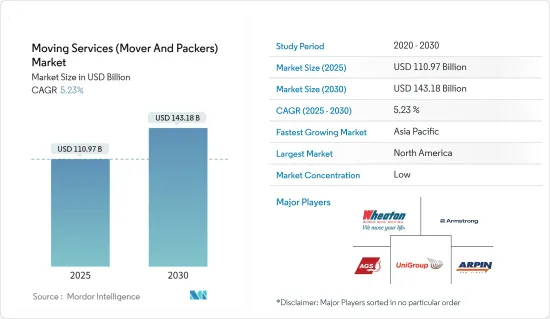PUBLISHER: Mordor Intelligence | PRODUCT CODE: 1645083

PUBLISHER: Mordor Intelligence | PRODUCT CODE: 1645083
Moving Services (Mover And Packers) - Market Share Analysis, Industry Trends & Statistics, Growth Forecasts (2025 - 2030)
The Moving Services Market size is estimated at USD 110.97 billion in 2025, and is expected to reach USD 143.18 billion by 2030, at a CAGR of 5.23% during the forecast period (2025-2030).

The moving services sector is crucial in assisting both individuals and businesses with their relocation requirements worldwide. It has undergone significant growth and change due to shifting demographics, urbanization, and evolving consumer desires. There is a noticeable shift in relocation preferences, with suburban and rural areas gaining traction due to the enduring appeal of spacious homes and outdoor settings. On the other hand, major cities remain attractive to young professionals pursuing career prospects and diverse cultural experiences.
During the COVID-19 lockdowns, mandatory stay-at-home orders led to an increased demand for spacious living areas. This prompted many individuals and families to seek larger homes with outdoor spaces and dedicated home offices. Consequently, there was a marked trend toward purchasing homes in less crowded areas, causing a surge in real estate demand outside major urban centers. Moreover, the COVID-19 pandemic's economic repercussions led people to adopt more careful strategies regarding relocations, with individuals and families re-evaluating their financial security and considering the uncertainties associated with moving during such times.
Real estate patterns and job-related moves play a pivotal role in shaping the moving services market. This industry continues to be substantial, providing employment to many individuals across different roles. Evaluating the market's resilience and its ability to adjust to economic changes remains a crucial area of focus for analysis and future projections.
Moving Services (Mover And Packers) Market Trends
Residential Moves Lead the Moving Services Industry
Moving services are utilized in diverse scenarios, including residential, commercial, and international transfers, specialized moves, and packing and unpacking situations. Residential moves significantly lead the moving services market, driven by increased relocations. The reasons for moving remain varied, emphasizing finding larger and more comfortable homes, especially with the continuation of remote work setups. Moreover, lifestyle shifts, the quest for enhanced amenities, and the pursuit of more affordable living expenses have emerged as key driving factors for relocation.
The growing presence of technology is seen in the incorporation of inventive digital instruments that improve customer satisfaction and simplify the relocation process. For example, moving quote calculators have transformed how customers obtain estimates, offering transparency and convenience, thereby driving the demand in the moving services market.
North America is the Largest Region in the Moving Services Market
The moving industry is one of the largest industries in the United States, employing over 6 million individuals as hand laborers and material movers. It is set to grow by around 6% in the coming six years, according to the Bureau of Labor Statistics. In the previous year, approximately 27.3 million Americans (8.6% of the population) moved, while the homeownership rate increased to 66% in November, according to the US Census Bureau notes. Despite higher costs, economic recessions might not deter relocations, especially with moving truck options available.
Moving Services (Mover And Packers) Industry Overview
The moving services (movers and packers) market is fragmented, with the presence of many players. The market strategy for the key players is to leverage technology to streamline operations and enhance customer experiences. This includes implementing online booking platforms, shipment tracking systems, and digital payment options. The key players include Wheaton World Wide Moving, Armstrong Relocation and Companies, UniGroup Inc., AGS Worldwide Movers, and Arpin Van Lines.
Additional Benefits:
- The market estimate (ME) sheet in Excel format
- 3 months of analyst support
TABLE OF CONTENTS
1 INTRODUCTION
- 1.1 Study Assumptions and Market Definition
- 1.2 Scope of the Study
2 RESEARCH METHODOLOGY
3 EXECUTIVE SUMMARY
4 MARKET DYNAMICS AND INSIGHTS
- 4.1 Market Overview
- 4.2 Market Drivers
- 4.2.1 Demand for Relocation Services Surging due to Shifting Lifestyles and Career Opportunities
- 4.3 Market Restraints
- 4.3.1 Economic Downturns Reduce Demand for Moving Services
- 4.4 Market Opportunities
- 4.4.1 Enhanced Customer Experience and Operational Efficiency Through Technology Integration
- 4.5 Value Chain Analysis
- 4.6 Industry Attractiveness: Porter's Five Forces Analysis
- 4.6.1 Threat of New Entrants
- 4.6.2 Bargaining Power of Buyers
- 4.6.3 Bargaining Power of Suppliers
- 4.6.4 Threat of Substitutes
- 4.6.5 Intensity of Competitive Rivalry
- 4.7 Insights into Technological Advancements in the Industry
- 4.8 Impact of COVID-19 on the Market
5 MARKET SEGMENTATION
- 5.1 By Type
- 5.1.1 Full-service Moving
- 5.1.2 Partial-service Moving
- 5.2 By Application
- 5.2.1 Residential
- 5.2.2 Commercial
- 5.2.3 Other Applications
- 5.3 By Geography
- 5.4 North America
- 5.4.1 United States
- 5.4.2 Canada
- 5.4.3 Rest of North America
- 5.5 Europe
- 5.5.1 United Kingdom
- 5.5.2 Germany
- 5.5.3 France
- 5.5.4 Russia
- 5.5.5 Italy
- 5.5.6 Spain
- 5.5.7 Rest of Europe
- 5.6 Asia-Pacific
- 5.6.1 India
- 5.6.2 China
- 5.6.3 Japan
- 5.6.4 Australia
- 5.6.5 Rest of Asia-Pacific
- 5.7 South America
- 5.7.1 Brazil
- 5.7.2 Argentina
- 5.7.3 Rest of South America
- 5.8 Middle East and Africa
- 5.8.1 United Arab Emirates
- 5.8.2 South Africa
- 5.8.3 Rest of Middle East and Africa
6 COMPETITIVE LANDSCAPE
- 6.1 Market Concentration Overview
- 6.2 Company Profiles
- 6.3 Wheaton World Wide Moving
- 6.4 Armstrong Relocation and Companies
- 6.5 UniGroup Inc.
- 6.6 AGS Worldwide Movers
- 6.7 Arpin Van Lines
- 6.8 U-Pack
- 6.9 Beltmann Relocation Group
- 6.10 Sirva Inc.
- 6.11 Atlas World Group Inc.
- 6.12 ArcBest Corp.
- 6.13 Coleman World Group
7 FUTURE MARKET TRENDS
8 DISCLAIMER AND ABOUT US




